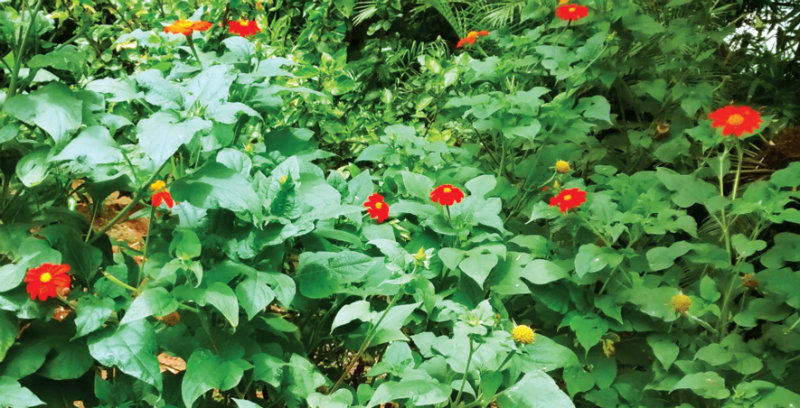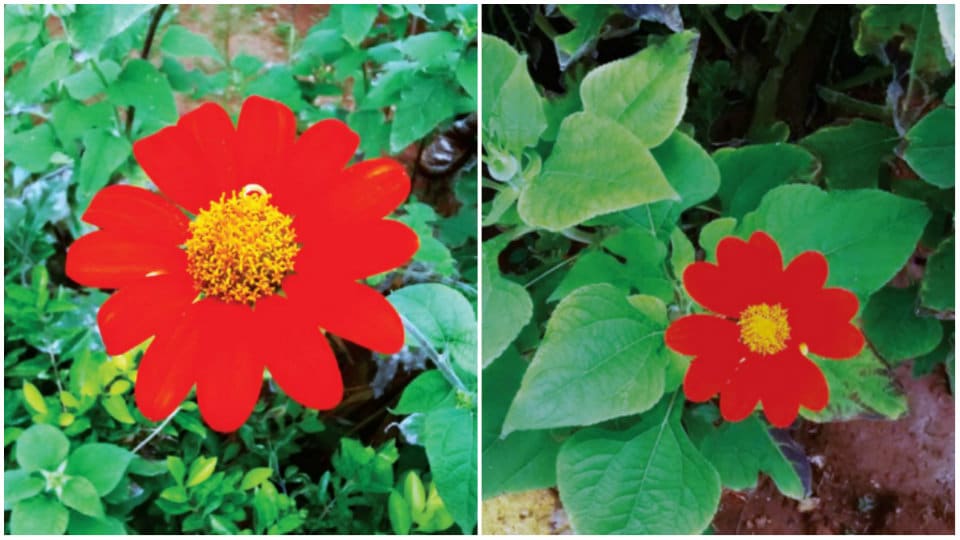Text & photographs by Dr. Mahadeswara Swamy
Scientist, Mob: 97429-91057 e-mail: [email protected]
The ‘Mexican Sunflower’ with its charming ‘vivid red’ or ‘orange-red’ inflorescence with a bright yellow centre is among the few flowering annuals which can be easily grown in tropical climate. This exotic floral beauty is native to Mexico, Central America and West Indies. It belongs to the sunflower group of plants of the family Asteracea and the botanical name is Tithonia rotundifolia. The generic name ‘Tithonia’ is christened after Tithonicus, the lover of Aurora, the Goddess of Dawn; ‘rotundifolia’ is from the Latin meaning “round leaves” (a misnomer).
This herbaceous plant with shrub like appearance is a free flowering annual but grows almost like a perennia weed under favourable conditions. It is a half hardy plant with green and pinkish brown stems. The simple leaves, alternate with one another are coarse to touch and vary in shape. They are ovate to triangular and often lobed with three prominent veins; mature leaves measure 6-12 inches. The petioles or leaf stalks are flat and winged, narrowing towards the base and folded at the joint of the stem (node). The most conspicuous part of the plant is the bright orange coloured inflorescence with yellow disc florets and golden-yellow to orange-scarlet rays held on long cylindrical hollow stalks. The petals are dark orange on the upper side and dull yellowish orange on the lower side. For me, the flowers resemble more of big sized Zinnias rather than Sunflower.
The hybrid variety ‘torch’ is a short and compact plant and produces brilliant orange red flowers.

Gardening
The plant is suitable for tropical and sub-tropical warm climates. The monsoon season (June-October) with humid climate is the ideal season to grow in Mysuru. The plants are suitable for big size flower beds. The plants need well-drained light soil. The recommended soil mixture is red soil or garden soil, river sand, cow dung manure or farm yard manure and leaf mould in equal proportion with ¼ kg of bone meal for 100 sq. ft. of flower beds. In fact digging plenty of organic matter to the soil is beneficial. The plant needs good sunlight and moderate watering.
Propagation
Seeds can be planted in situ in beds. Seedlings can also be raised in seed pans or seed beds in the nursery. Sowing depth is ¼ to ½” and spacing 1”. The plants germinate in 10 to 12 days time and can be transplanted in beds at the 4 leaf stage with a spacing of 24”. The plant flowers in 10-12 weeks of sowing.
Where to see
Beautiful specimen plants can be seen in the premises of Bharath International Travels (BIT) office, Dewan’s Road in city.
Useful Tips
It makes a spectacular background plant and adds instant colour to any landscape, a good choice for borders; can also be grown in big pots.
It goes well with herbaceous annuals like Hollyhock, Dahlia, Blue Salvia, etc., in mixed beds. But it should always be placed behind other plants.
Plants need stalking especially the taller varieties in windy areas.
If not checked, the plants go out of control and expand their area.
Keep the soil evenly moist but do not over water the plants. If the soil condition becomes very dry the leaves droop down.
When the plants become too old, the leaves on the lower side start withering signalling that it is time to remove them.
It is a good source of cut flowers for floral arrangements and a good substitute for Zinnias. Cut the young flowers and place them in water immediately. The hollow floral stocks are brittle and break if not handled carefully.
Allow seed-heads to dry on plants. After drying, collect the seeds and store in a dry place. Removing the dried old flowers also prolong blooming.
It attracts butterflies, insects and humming birds and an excellent plant for butterfly gardening.
There is no serious pest problem and insect population.








Recent Comments